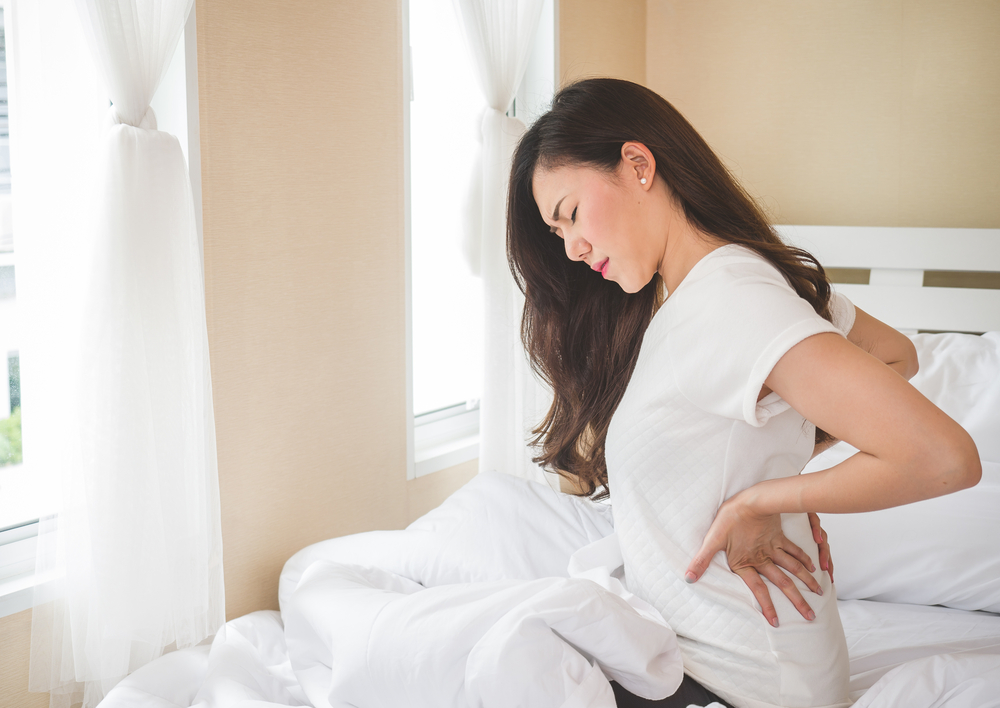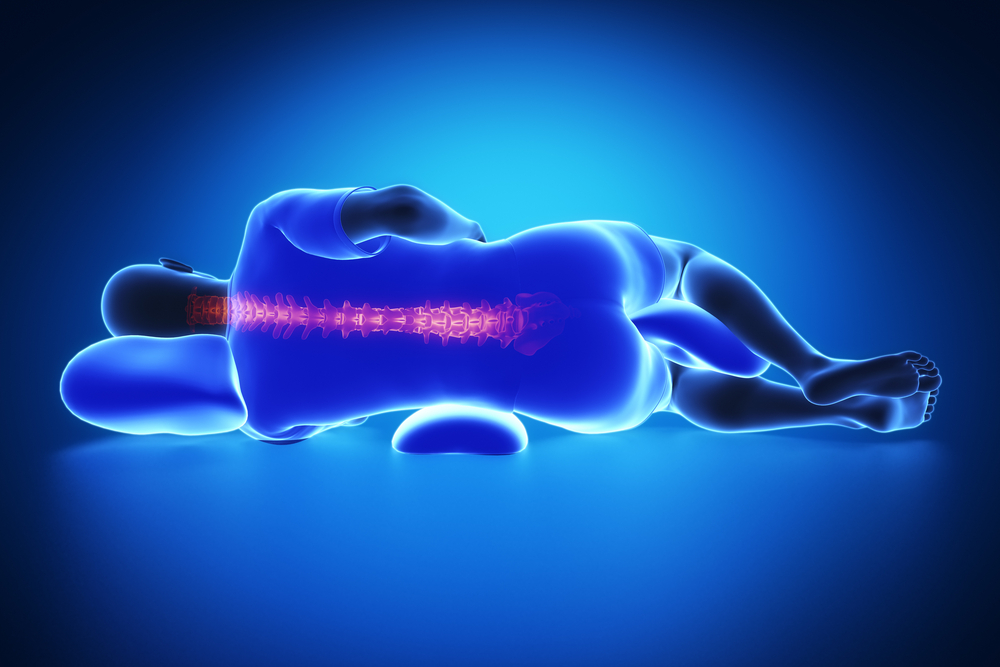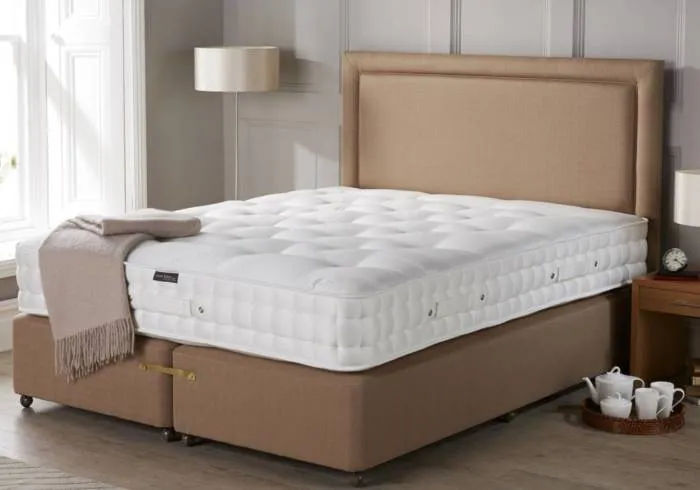Sleep & Well Being, Mattress Tips
September 2022Best Sleeping Positions For Back Pain
Do you often wake up with back pain? If so, you’re not the only one. Around 10 million people in the UK do, and that number spans various age groups.
Unfortunately, it’s all too common for people’s sleep experience to suffer because they’re constantly waking up to aches and pains in the morning. You might be surprised to learn that most back pain isn’t actually the result of a serious medical condition like fibromyalgia, or arthritis. More often than not, it comes from a combination of stress, your mattress, and not knowing the best sleeping position for lower back pain.

Updated for 2022: Since the Covid-19 pandemic, many people have taken to working from home. Whilst this brings plenty of benefits, it also potentially leads to more back pain as a result of makeshift desk setups. With this in mind, we wanted to update our previous exploration of how to sleep with a bad back, especially the best sleeping positions for lower back pain.
Why do we get lower back pain?
The lower back includes the 5 vertebrae of the lumbar spine. These are reinforced by shock-absorbing discs, ligaments and the like. Put simply, the lower back is responsible for taking most of the body’s weight. 8 out of 10 people experience lower back pain at some point, and it’s a leading cause behind doctor’s appointments.

The two types of lower back pain are:
- Acute – short-term discomfort that lasts up to a few weeks. It’s often linked to an injury, and leads to no discernible ongoing effect.
- Chronic – long-term discomfort that lasts for longer than 3 months. There may be no clear link to an injury. Around 20% of cases that involve acute back pain progress to chronic back pain.
Doctor’s assistance with lower back pain should be sought if it:
- Seems to stem from a specific injury.
- Gets worse/carries on for more than a few days.
- Becomes restrictive or debilitating.
- Affects the legs or other body parts.
- Comes accompanied with signs of an infection.
- Comes with other health problems.
Lower back pain can prevent a person from getting a good night’s rest, as the pain can make it difficult to fall (or stay) asleep. However, there’s also a theory that people who sleep worse are more likely to develop back pain. This may be because such people experience impaired healing capabilities, or heightened perceptions of pain.
Good sleep hygiene can be a good starting point for people who experience any sort of sleep disruption. However, for specific sleeping issues that clearly relate to back pain your sleeping position plays a part too. Putting pressure on the lumbar spine can cause various problems. The following are the best sleeping positions for lower back pain, and should give you a better chance of getting the soothing night’s rest you deserve.
On your side with a pillow between your knees

One position you could try if you’re often uncomfortable in bed is sleeping on your side.
- You want your left or right shoulder to make contact with your mattress, while placing a pillow between where your knees meet. The pillow will actually help to keep your hips, pelvis, and spine more aligned.
- If there’s a gap between your waist and the mattress, a small pillow can be used as a support there too.
- Ideally, you only want to flex your hips and knees a little bit, to prevent undue pressure on your neck.
- Remember, whenever you sleep on your side try not to sleep on the same side every night. This can lead to other health issues, such as muscle imbalance and even scoliosis.
- You could consider a full-length body pillow, if you prefer.
In this position, it’s actually the pillow between your legs that really makes the difference. This is what promotes a better alignment, so don’t forgo it in favour of just side sleeping.
On your side in the fetal position

If you prefer sleeping on your side but you don’t like the sound of using a pillow between your knees, then try to curl up into the fetal position before you drift off.
- This means tucking your knees in towards your chest, while you curl your torso towards your knees. By doing this you’ll open up the space between your vertebrae, which can help ease nerve pain and weakness.
- Don’t curl up too tightly. This can not only restrict your breathing, but also aggravate a sore back.
- Switch the side you sleep on periodically to prevent any imbalances.
Keep in mind that this position is definitely not ideal if you suffer from arthritis. In that case it would be best to keep your body straightened as much as you can. However, it’s certainly advised for sufferers of a herniated disc.
On your back with a pillow under your knees

Many people find lying on their back to be the most effective sleeping position when it comes to relieving back pain.
- If you prefer to sleep on your back, then try placing a pillow underneath your knees so that your legs are slightly elevated. This helps to keep your head, neck and spine rested in a neutral position, putting less pressure on your back and other pressure points.
- Support your head/neck with a pillow, as normal.
- You could also try putting a small rolled-up towel under the small of your back. This gives even more support if there’s a gap between you and your mattress.
Sleeping on your back evenly distributes your weight across the widest area. This means it places much less strain on pressure points, reducing the risk of lower back pain.
On your stomach with a pillow under your abdomen


Sleeping on your stomach is not usually the most ideal position for back pain. This is because it can end up putting more stress on your neck, leaving you with neck pain in the morning. However, if you really prefer this position then you don’t necessarily have to force yourself to change.
- Try placing a pillow under your pelvis and lower abdomen, as this will help to relieve some of the pressure.
- Be open to using/not using a pillow under your head, depending on how much strain you feel is being placed on your back.
This position can also aid in relieving any stress that’s placed on the space between your discs, making it more beneficial if you suffer from degenerative disc disease.
Even if you regularly adopt your personal best sleeping position for lower back pain, it’s important to focus on the alignment of your spine when you sleep. If you notice gaps between your body and the bed, this is when there’s a case for using pillows or towels to reduce the strain on your muscles or spine. Remember that your mattress can play a pivotal role in relieving your back pain too.
Firm Orthopedic Mattresses can actually cause back pain
We get so many customers who have been told to choose a firm mattress to help with their bad back. There are many discussions in our Ask a Question section where people have been incorrectly advised that the best mattress for a bad back is a firm one. The mattress industry has even invented its own term for these super-firm, concrete-like mattresses: Orthopaedic. However, did you know that a firm mattress can actually cause you more distress and back pain? We’ve written a really detailed article all about it to show you what to avoid.
| Spring Tension | Wire diameter (Gauge) | Weight Range |
|---|---|---|
| Soft | 1.2mm | Bespoke Tension (Please Call) |
| Medium | 1.4mm | Upto 16 stone |
| Firm | 1.6mm | 16 stone plus |
| Extra Firm / Orthopaedic | 1.9mm | 20 stone plus |
What you really need is a mattress that is supportive for your body weight, and everyone’s weight ranges are different. That’s where you need some expert guidance, which we can provide. Why not get in touch before spending a fortune on a firm mattress that may actually make your sleep worse?
Your mattress matters when it comes to back pain
At John Ryan, we take the quality of your sleep seriously, and we’re proud to offer a range of luxury mattresses for back pain. All these are tailored and tested to give you all the support and comfort you need to alleviate those aches.
For example, our Pocket Sprung mattresses utilise individual springs, cushioned in their own breathable pockets. These fully support the whole of your body and adjust themselves to the shape it makes. There’s also our Origins 1500 and our Artisan Naturals mattress, which are designed to help support and soothe you if you frequently sleep on your back and suffer from back pain.
By choosing the right mattress, you can make waking up to back pain a thing of the past, and we are here to guide you through all the options available to you. We’ll find you a mattress that’s tailored to your height and weight, and that’s able to adapt to your every movement and sleeping position.
For more information about mattresses for back pain, get in touch on 0161 437 4419.
</2>

Dreaming of the perfect nights sleep?

Ask us a question
There are over 6000 questions and answers submitted by you on all questions about mattresses and bed problems. Enter a keyword such as Vi Spring, John Lewis beds, bad back or Memory Foam and see if your question has already been answered.
If you can’t find an answer in knowledge hub, ask a new question. We aim to respond to all questions within one working day.
Newsletter
Enter your email to join our newsletter. We’ll send you occasional news and mattress expertise.

